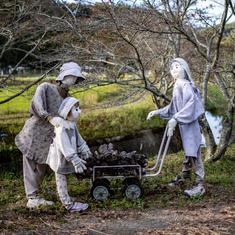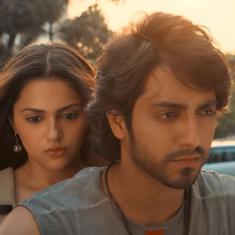On picking up a translation, one assumes that there is a core literary work, around which a scholarly apparatus is gathered. But what if the literary work depends intrinsically on a scholarly, or at least very educatedly self-aware, apparatus? This is the case with Manoj Kuroor’s The Day the Earth Bloomed (translated from the Malayalam by J Devika). The protagonist of the novel, set millennia ago, is less a character, and more the language. The language here is what one might call a deeply Tamilised Malayalam.
Tamil / Malayalam
The entanglement of Tamil and Malayalam is millennia old, and it is hard for a non-partisan to argue when Malayalam may legitimately claim a separation. Yet, as Kuroor demonstrates, there is much to be gained from embracing that heritage – Malayalam is only enhanced. We cannot know, or hear, what exactly was spoken in (what is today) a Malayalam country seventeen centuries ago – and it would be anachronistic to ascribe ethnicity or tribe, Malayalam or Tamil, to these peoples and their speech.
What we do have preserved more tangibly are classical Tamil poems, and so a language has to be stitched together today that is in Malayalam but was, as the author KR Meera helpfully explains in the blurb, “rooted in the fertile soils of the Dravida [Tamil] tongue”. As translator Devika further explains: “Malayalis write closer to Sanskrit, but speak closer to Tamil”. The noted scholar David Shulman also opines that what has been achieved by Kuroor is quite a marvel – it is as if a classical poet was reborn in the current moment and wrote a poem for us today – all the while retaining much of his classical vantage!
The classical, however mediated and indirect, is thus not only alive, but also putting forth new shoots in many parts of the country. It is impossible for a translation to capture these multiple registers of time and language–what has been achieved, however, is still well worth reading, especially if one is familiar with the Sangam poems of classical Tamil (again, even if in translation). The translator captures a keen sense of the ancient, of wandering bards, of a life carved amidst both music and war.
Songs within songs
The structure of the story is modern and novelistic – the are three first-person accounts of a father (Kolumban), a daughter (Chithira), and a son (Mayilan). The son runs away, and years later, the father and daughter set out to find him and restore some measure of unity to that broken family. Out of the bare, strong bones of such a structure, Kuroor has fashioned an evocative tale of travel, poverty, and beauty.
The lyrical language foregrounds a sense of collective subjectivity beyond the three first-person accounts. It is as if a moving, allegorised crowd of singers, weavers, liturgists, lyre-carvers, were made to move with children and grandparents, in various directions, even amidst thunderstorm, due to numerous wars being fought on all horizons. Devika retains some of the flavor of the original by retaining many Tamil/Malayalam words, especially of flowers or birds – what is to be gained by an accurate Latin or English translation of these, even assuming we always knew what these ancient words referred to?
Within this collective pathos, there is the individual one of a single, runaway son. The journey results in the father’s death, and the daughter takes over the telling. There is much verse, as Kuroor is also a poet, and the continuity of prose and poetry provides both variations and improvisation. There are songs within songs, memories within memories, as the mother remembers her dead husband, and wonders if her eldest son is dead too, unmourned and unattended.
The eldest son, it turns out, is guilty of much as he rages against his poverty – there is treachery toward his father, gratuitous arson against bison and leopard, a repudiation of the world of his parents’ art for the world of banditry and wealth. Banditry, as it turns out, has its own art – of hunting and swordsmanship. Joining such a savage group helped him travel along routes different from his bardic parents. He gets to see the sea and not merely sing of it. He also sees large new cities with lush orchards, as well as heaps in the bazaar of opium and cinnammon. In time, in his quest for power, he realises he must learn more formally of the science of governance and statecraft. Though he begins in a lowly employment, he is capable and opportunist enough to rise through all the war and realpolitik. But in time, he realises the cost of such ambition, the loss of family, his ever-increasing isolation. By the end, he is contrite: “All that I had thought was buried and gone may rise up from its grave any time to sting me again. I must run away and hide from this very world”.
Thus, in its broad moral contour, the story is formulaic enough – the beauty lies in its distinct, plaintive language. Kuroor is well positioned to execute such a project – he is a poet, a professor of Malayalam, a writer of kathakali texts, as well as a trained percussionist. The rhythms of many traditional instruments, and indeed of an entire classical oeuvre, reverberate throughout this magniloquent novel.
Nikhil Govind is the author, most recently, of The Moral Imagination of the Mahabharata (Bloomsbury, 2023).

The Day the Earth Bloomed, Manoj Kuroor, translated from the Malayalam by J Devika, Bloomsbury India.










